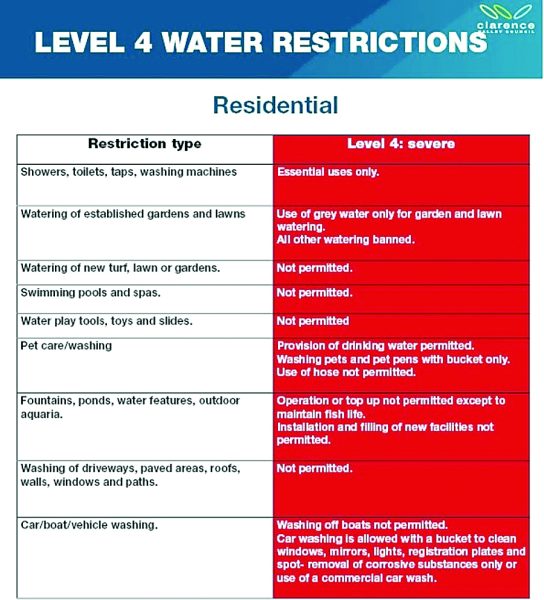Rodney Stevens and Emma Pritchard
Clarence Valley Council (CVC) General Manager Laura Black has revealed she is unsure how long Level 4 (Severe) water restrictions introduced last week for the whole Clarence Valley water supply system due to a prolonged dirty water event following recent rainfall in the Nymboida River will remain in place but said council should have “a better idea later this week.”


The restrictions were issued by council on January 30 to avoid the need to call a Boil Water Alert.
As of February 6, the rural community of Coutts Crossing remains on a Boil Water Alert, while Minnie Water and Wooli residents who receive their water supply from Lake Minnie Water and Lake Hiawatha, do not have to adhere to restrictions.
Level 4 (Severe) water restrictions ban all outside watering, except the use of grey water.
In a statement released last week, council revealed the return flow from Coffs Harbour was interrupted late last year following a fire at Karangi Dam, and reliance on the water supply was switched to the Nymboida River.
Since the March 2022 rainfall event, the water in the $94 million, 30000 megalitre Shannon Creek Dam has been too dirty to use.
This is thought to be due to impacts from the 2019 bushfires.
Council also revealed they have implemented several measures to mitigate the risk of water restrictions since December 2022, including constructing a settling pond at Rushforth Road Water Treatment Plant due for completion later this month, weather permitting, and sourcing and installing temporary water filtration units at Glenreagh and Coutts Crossing to be installed in early February.
Monitoring of both the water supply scheme and the intake at the Nymboida River have been occurring 24/7 to avoid earlier restrictions and Boil Water Alerts, and to resume drawing water from the river to replenish supplies.
Recently, council has been able to renegotiate the return flow of clean water from Coffs Harbour which commences this month.
Following discussions with NSW Health, a strategy has been developed to lift the Boil Water Alert for Coutts Crossing.
This involves emptying, cleaning, and refilling the reservoir with clean water from Coffs Harbour, which was scheduled to take place on February 7.
While the reservoir is bypassed, town water supply to Coutts Crossing will be maintained by directing water straight from the Coutts Crossing Treatment Plant, although some residents may experience a reduction in water pressure.
Once the work is complete, NSW Health is required to formally approve the lifting of the Boil Water Alert for Coutts Crossing.
At this stage, council said cleaning the reservoir is estimated to take a day, but it is not known when NSW Health will lift the Boil Water Alert.
Council also anticipates the Boil Water Alert for Coutts Crossing to be lifted in early February, along with the Level 4 (Severe) water restrictions on town water supply.
When asked if there are currently any plans to implement a filtration system to improve water quality for all Clarence Valley residents on February 6, Ms Black said council received information about some work that needs to happen at the reservoirs prior to any filtration being implemented late last year, adding an Environmental Impact Statement (EIS) along with the draft master plan for the treatment plant at Rushforth will be considered by council at the upcoming meeting on February 28.
“That then will lead into what we do round filtration,” she said.
“It’s actually quite a long process, and council did also agree that this year they would do the consultation required.
“This council is certainly interested in progressing it.”